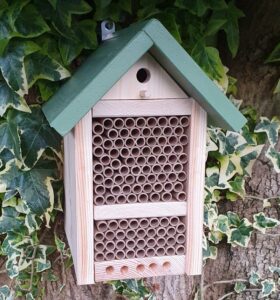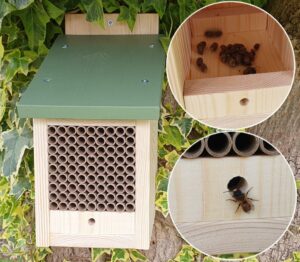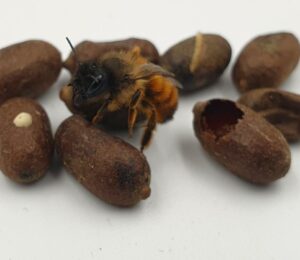8 October 2025
Harvesting Solitary Bee Cocoons
Its nearly time to Harvest Your Solitary Bee Cocoons
Between March and May, eggs are laid in a series of cells created inside each tube, so each tube contains a number of developing bees. As well as the eggs, each cell is filled with pollen for the developing bee larvae to feed on. Over the next few months, the larvae will feed before pupating and eventually develop into a bee ready to emerge when temperatures rise the following spring. We recommend removing the cocoons from the tubes to ensure that as many survive as possible, because if a bee dies in the front of the tube, the rest will not be able to get past and will perish. By removing the cocoons in early Autumn, you give them the best chance to emerge PLUS you can remove any parasites like pollen mites and any pests like the larvae of the Houdini fly. You can simply leave the cocoons in situ outdoors and see what emerges, BUT harvesting your cocoons is not only good for the bees, its also a chance to share extra cocoons with friends and neighbours PLUS its fun!!
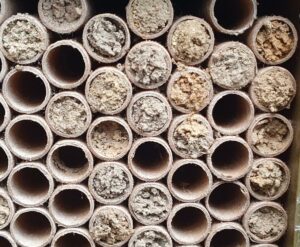
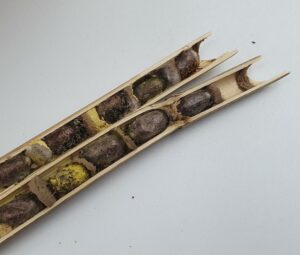
When to Harvest :- You can harvest in the Autumn i.e. in October / November or in the new year i.e. January / February. However the earlier you do it the safer your bee cocoons will be.
How to Harvest :-
- Harvesting Mason bees can get a little messy! Inside the tubes / reeds / trays you won’t just find cocoons, but also mud, bee poo, pollen and possibly parasites i.e. pollen mites.
- Its best to soak cardboard tubes to soften them to allow you to extract the cocoons, reeds can be split with a sharp knife while a flat head screw driver / or a specialist tool is ideal for prising cocoons out of trays.
- Once you have extracted the cocoons its time to wash them. Mason bee cocoons are waterproof and can tolerate up to 20 minutes of soaking. Fill a bowl with cool water, add the cocoons, and gently stir to remove any debris. The cocoons will float to the surface, so gently stir to clean the cocoons and then lift them out (a slotted spoon works well) onto some paper towels.
- After washing, use a colander to remove the cocoons from the water, then gently pat them dry with paper towels. Let them air dry for about 30 minutes.
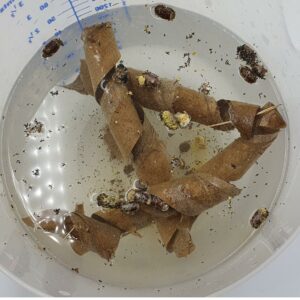
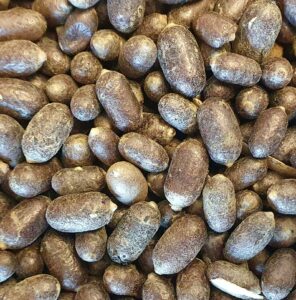
Storing your cocoons :- After cleaning, the cocoons can then be stored in a cool place / refrigerator until the following spring – when you can put them back into your Bee Hotel / House ready to start the whole process again. While not natural, popping them in the fridge works really well – we recommend setting your fridge temperature to ~34°F (1°C).
Inspect your houses :- Having harvested your cocoons, check your houses for damage and clean if needed. This is also the time to replace remove / damaged tubes ready for re-positioning in the spring. We have BOTH Cardboard Tubes and Reeds available.
Check your cocoons – It’s a good idea to check your cocoons for any mould and if necessary you can wash them again.
When to pop them outside :- In the spring the cocoons will start hatching around March / April and will start hatching once they warm up – a daytime temp of 13c for 2-3 weeks will trigger hatching. Normally in late Feb / early March it’s time to pop your cocoons back outside using either our release box or a Bee House with a release Base or a Bee Hotel with a release Chamber.
Bee Cocoons are available to buy in the New Year – Use these Solitary Bee Cocoons to boost the number of solitary bees in your garden. These UK bred solitary bees are supplied as cocoons in a cardboard release box. Supplied in a cardboard release box, simply push out the pre-cut hole and position the box in a sheltered place (it is NOT weatherproof and will need protection from the rain i.e. in greenhouse / shed etc) next to where you want them to nest or add the to one of our release houses. Each cocoon contains a Red Mason Bee that is normally active in the garden from March to July pollinating top fruit and soft fruit. These cocoons have been bred for us in the UK and kept cool to keep them in top condition over the winter. Ideally release them next to a bee house to encourage them to nest again in your garden.
Available to buy now
Solitary Bee Nesting Tubes
Use these replacement cardboard Solitary Nesting Tubes to replace tubes in Solitary Bee Nests or use them to make your…
Solitary Bee Reed Bundle
Each bundle of Solitary Bee Reeds contains approx 100 x dry reeds approx 18cm long, which can be used to…
Solitary Bee Reed House inc Reed Bundle
The Solitary Bee Reed House is an attractive, wall-mountable wooden bee house that holds removable natural reed nesting tubes, that…
Solitary Bee Hotel with a Release Chamber
This Solitary Bee Hotel have been designed to as attractive as possible to Solitary Bees to encourage them to nest…
Solitary Bee House with a Release Base
This Solitary Bee House have been designed to as attractive as possible to Solitary Bees to encourage them to nest…
